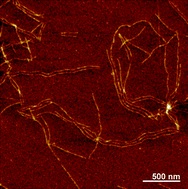In addition to the conference, the APS prizes and awards are conferred at the APS March meeting. Of the 18 awarded this year, 8 went to researchers in the soft matter field. Below I have highlighted some of the winners along with some information about their work.
John Dillon Medal – Raffaele Mezzenga, University of Fribourg
This prize was awarded to Mezzenga for exceptional contributions to the understanding of self-assembly principles and their use to design and control materials with targeted functionalities. Menzzenga’s work involves the study of protein fibrils. While important in neuro-degenerative diseases, protein fibrils are also found as building blocks in food. Menzzenga’s talk focused on his work on the formation of long linear multi-stranded protein fibre structures and their self-assembly. A discussion on how these fibres are formed was recently published in Soft Matter (doi:10.1039/c0sm00502a). Initially single filaments are formed. Short-ranged interactions between the filaments then lead to aggregation and almost perfect alignment of the filaments to form multi-stranded fibrils. Twisting of the fibrils then results from repulsive electrostatic interactions between the fibrils. Other recent papers look at the disassembly of protein fibrils (Soft Matter doi: 10.1039/C0SM01253J) and whether and how lyotropic liquid crystal phases can be used to host, encapsulate and direct the assembly of amyloid fibrils (Soft Matter doi:10.1039/c0sm01339k).
Polymer prize – Gary Crest, Sandia National Laboratory and Kurt Kremer, Max-Planck Institute for polymer research
This prize was awarded jointly to Crest and Kremer for establishing numerical simulation as a tool, on an equal footing with experiment and theory, in the field of polymer science, as exemplified by the seminal simulations of entangled polymer melt dynamics.
Biological physics doctoral thesis award “Evolution and emergence of structure” – Erez Lieberman-Aiden, Havard University
Lieberman-Aiden received this years award for outstanding doctoral thesis in biological physics. This is not the only award that Lieberman-Aiden has recently received. He was also the winner of the Lemelson-MIT student prize in 2010 for his inventive work on mapping out the 3-D structure of the genome. As a graduate student Lieberman-Aiden developed Hi-C, a new technology which allowed for the 3-D structure of the genome to be probed, providing insight into how the double helix DNA folds and fits in to the nucleus of a human cell. The results were published in Science. Further information on his work and publications can be found on his website.
Leroy Apker Award – Chai Wei Hsu, Wesleyan University.
The Leroy-Apker prize recognises achievements in physics by undergraduate students. The prize was awarded jointly to Christopher Chudzicki for his work on parallel entanglement distribution on hypercube networks and to Chai Wei Hsu for his work on the self-assembly of DNA-linked nanoparticles. Chai Wei Hsu looked at the phase behaviour of nanoparticles tethered with DNA strands and developed a theoretical description for the behaviour observed. These nanoparticles are able to self assemble into well ordered structures due to the complimentary bonding of base pairs. Chai’s thesis is available online here.
A paper on the self-assembly of DNA structures has also recently appeared in Soft Matter. In their article ‘Self-assembling DNA templates for programmed artificial biomineralization’, Samano et al. discuss the use of DNA-directed patterning of inorganic materials for various technological applications including electronics and photonics.
Max Delbruck Biological Physics Prize – Xiaowei Zhuang, Havard University.
This prize, for outstanding achievement in biological physics, was awarded to Zhuang for her contributions to the field of single molecule biophysics and super-high resolution imaging. A Professor at Havard, Zhuang’s research involves developing tools to visualise biomolecular processes on scales smaller than the resolution limit of conventional light microscopy. In her talk she discussed a new method of imaging – Stochastic Optical Reconstruction Microscopy (STORM). This technique utilises photo-switchable fluorescent probes. The final image is reconstructed from a series of images. Only a fraction of the probes are switched on for each image in the cycle, allowing the positions of the probes to be determined with nanometer accuracy. The imaging method was described in Nature Methods.
A full of prize winners for 2011 can be found on the APS website.











